Not familiar with PPF?
Here’s a quick rundown on what it’s made from, and how it works.
PPF consists of an ultra-thin polyurethane, or polymer, which when properly applied by a professional (typically an auto detailing or vinyl installation expert), forms a transparent protective surface layer. This disposable “skin” protects a car’s clear coat, as well as the paint beneath it from things like surface scratches, UV exposure, hard water deposits, acid rain, oxidation, and various other unpleasantries.
That said, there’s still a lot of confusion out there over what PPF can and cannot do, especially when exposed to extreme situations. The pendulum swings both ways too, with the pros and cons of PPF either being overly exaggerated, or completely understated.
So let’s shovel through the bullshit, and get down to the facts, because there’s much to be gained by having a paint protection film installed on your automobile, and a lot that can go wrong as well…
WHAT IS PAINT PROTECTION FILM?
PFF is an ultra-thin polymer or polyurethane layer that acts as a transparent protective layer over a surface.
This “skin” like coat protects a car’s clear coat and its paint from sustaining damage or weathering.
Is PPF Worth It?
- Yes, installing PPF paint protection protects against:
- UV rays
- Acid rains
- Surface scratches
- Oxidation
- Hard Water deposits, etc.
However, it is not effective against dents and other larger impacts. If you feel your vehicle does not face such extreme issues, you can install PPF.
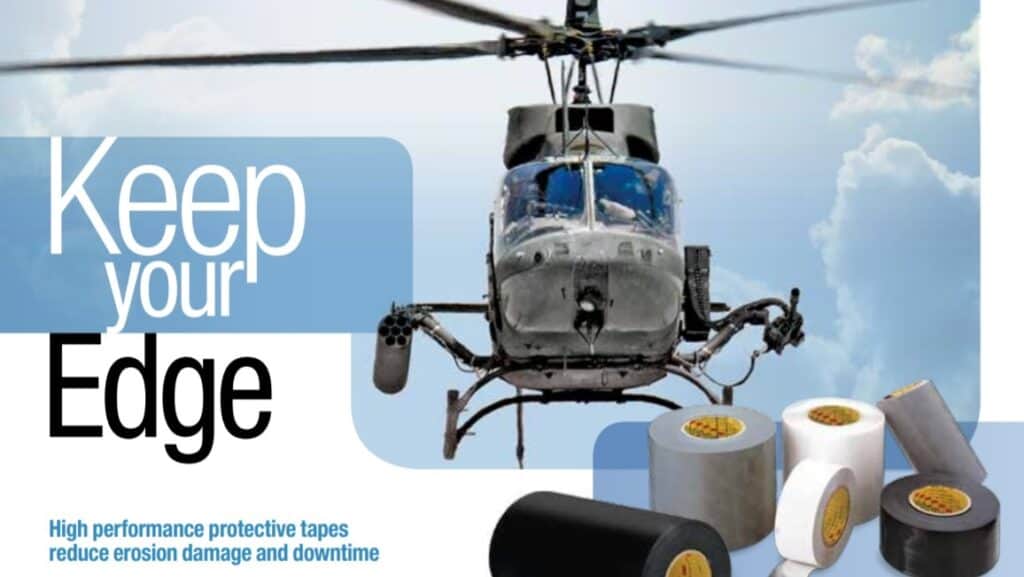
A Little PPF History Lesson
Much like America’s favorite lubricant, (we’re talking about WD-40 here… pervert), paint protection film was not originally intended for automobiles or civilian use, but was developed as a tool for military operations.
It was the height of the Vietnam War, and the U.S. Department of Defense (D.O.D.) was receiving one report after another of helicopters being significantly damaged by shrapnel and debris. This was especially apparent on areas like rotor blades, and across surfaces carrying sensitive military equipment.
According to automotive experts, the D.O.D. set out to find a solution, which is precisely when good old 3M comes into the picture. The textile and chemical giant was gung-ho about finding a solution to this problem, and tasked some of its greatest minds with developing a protective layer that could be just as resilient as it was transparent and lightweight.
Before long, the U.S. military was presented with what appeared to be a solid solution to its chopper problem. By modifying the chemical structure of a super strong urethane film, 3M’s engineers had developed a product that could withstand both significant amounts of elemental abuse, and moderate surface damage from things like artillery shrapnel. Inexpensive, relatively easy to apply and replace, and resistant to UV degradation and common aviation fluids, this film was an instant success.
Due to its ability to conform to almost any surface, and then form a tight bond with whatever it was allowed to cure atop, this film became commonly referred to as helicopter tape, or “heli tape” for short. Today, this product is still marketed as heli tape in certain global markets, even though it is rarely used for its intended original purpose.
“Polyurethane Protective Tapes provide a cost-effective way to help prevent structural damage to helicopter rotor blades with minimal effect on blade track and balance. These tapes can significantly reduce rain and sand erosion damage … Foreign Object Damage (FOD) … life cycle costs and helicopter downtime.”
-3M Aerospace and Aircraft
Maintenance Division
Quick Nerd Note: Since PPF started life as a military application, there was no need for it to create a glossy, or completely clear appearance, therefore early versions were either completely opaque, or a dull, hazy-looking sheen.
PPF’s Transition to Automobiles

Over time, 3M began to refine and re-engineer this revolutionary military protective film for use in the civilian sector. However, it literally took decades for PPF to evolve into the high-quality thermoplastic urethane film of today, and almost as long to catch on in regard to popularity.
While selling the military on a tape-like protective film that would keep helicopter parts from being damaged was fairly easy, getting car owners to agree to having their vehicles cloaked in super strong “plastic wrap” was a huge challenge. Offered as a “protective topcoat for painted surfaces,” and sold in a kaleidoscope of colors and thickness levels, car paint protection film slowly but surely grew in popularity.
Eventually, high-end car owners and detailing shops began to buy more of these pricey film coatings, as their protective benefits and projected longevity indeed lived up to the hype. Everything from bug splatter and bird droppings, to surface scratches, rock chips, and all manner of oxidization and UV damage were rejected by PPF, and it looked like the product was set to become one of the biggest game changers in the history of car care.
Paint Protection Films of Today
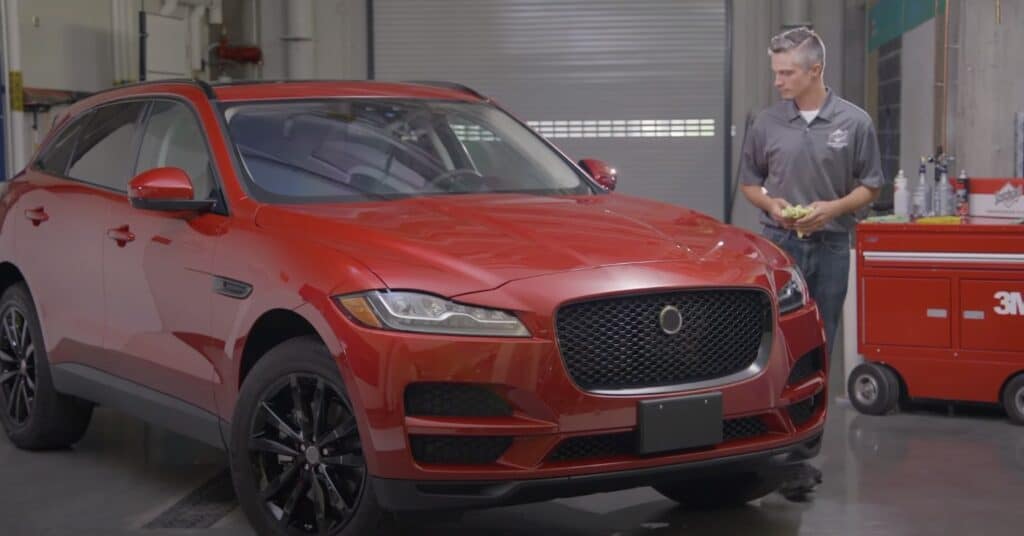
Nowadays, 3M’s line of automotive paint protection films come in two offerings: A Pro Series (also known as clear bra), and a colored Matte version. Both are backed by a 10-year warranty, and when properly installed by a professional, offer what 3M refers to as “unrivaled scratch and stain resistance.”
With their ability to be custom designed to fit a specific vehicle, unique “self-healing characteristics,” and ability to match most factory matte paints, 3M’s PPF offerings have seen a significant growth in popularity in recent years.
Quick Nerd Note: The top layer of the PPF is comprised of an elastomeric polymer substance that helps the material maintain a natural shape once it’s been stretched or applied to something like a painted or clear coated surface. This allows the PPF to “self-heal” when light scratches occur, and pretty much eliminates any risk of swirl marks.
Types of Paint Protection Film

While 3M may have created PPF, and fine-tuned it for automotive applications, there are a handful of other manufacturers out there offering paint protection films. Some of these companies include Suntek and Llumar, both of which are offshoots of the Eastman Chemical Company, and XPEL, which is the official protective film partner of Team Penske.
A few nicknames for these protective products include:
- Clear Bra
- Clear Mask
- Invisible Shield
- Clear Wrap
- Car Protection Film
PPF vs. Vinyl Wrap
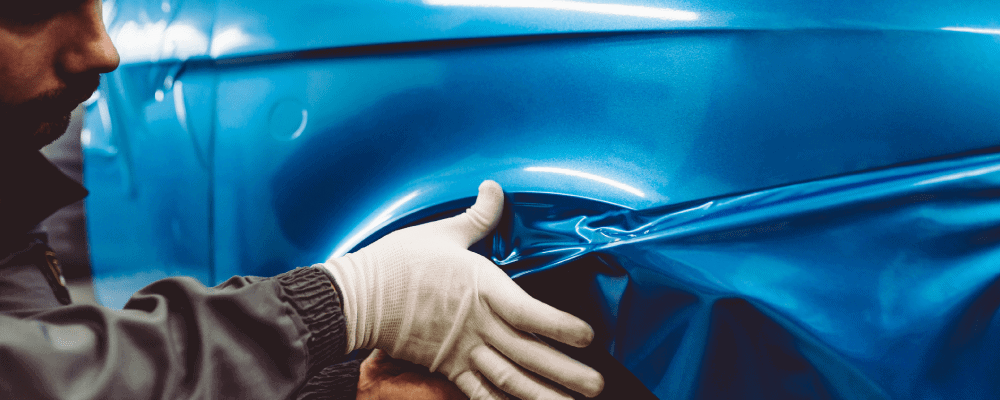
There’s a lot of confusion about the differences between PPF and vinyl, or if there is any difference whatsoever. So here’s a breakdown of the nuts and bolts that make each of these clingy products unique.
Vinyl Wrap
Vinyl wrap is a relatively thick substance, which makes it much easier to install and provides additional coverage, but it is not transparent. The PPF, on the other hand, is not a tint. It’s usually crystal clear, is much lighter, and self-heals when scratches occur.
Paint Protection Film
When placed next to a run-of-the-mill roll of vinyl wrap, it becomes apparent that PPF is a far thinner, and far more lightweight alternative. The perks of procuring it in either a clear or tinted shade are also unique unto PPF, as are its ability to offer superior surface protection and “self healing properties,” both of which vinyl has in limited supply.
So while a vinyl wrap may offer some level of paint protection, it is typically installed for aesthetic or marketing purposes, because shipping trucks are basically rolling billboards, right? In contrast, a PPF is going to either be a matte-like armor, or if transparent, a see-thru shield that allows glossy painted surfaces to safely shine underneath.
Self-Healing Paint Protection Film
As stated above, the auto paint protection film has a top layer of elastomeric polymer, which attributes the film to “self-healing” capabilities. This is what we call self-healing paint protection film.
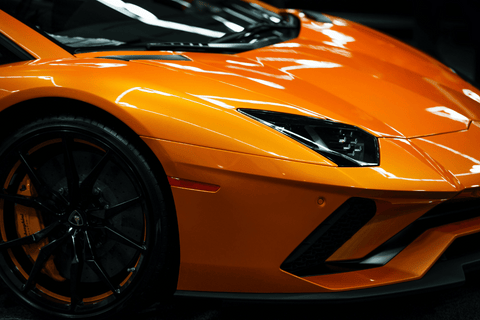
Paint Protection Film Cost
Here’s all you need to know about the cost of paint protection film price:
How Much Does PPF Cost?
Full front-end coverage of a standard vehicle with PPF can cost you somewhere between $2000-$2,500. However, this cost heavily depends on how many panels you want to cover and who is doing it for you.
Why is PPF So Expensive?
The materials and technology used to develop PPF are costly, which in turn increases the cost of the film itself. Moreover, additional technologies like self-healing and hydrophobicity increase the amount further.
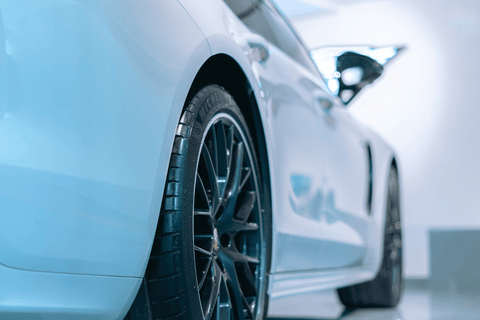
5 Popular Paint Protection Film Products
The following are some of the most widely used paint protection film products:
1. XPEL ULTIMATE
XPEL ULTIMATE is by far one of the finest films in the market. This material will protect your scratches, stone chips, scuffs, and other minor damages.
Moreover, it comes with a 10-year warranty for yellowing and peeling. The best part is that you can put a ceramic coating on top of it to further protect your vehicle’s surface.
2. Suntek
The protection film by Suntek doesn’t provide as much protection as XPEL, as it is significantly thinner. But if you are looking for something that offers a glossy finish, Suntek is the PPF for your car.
3. VViViD Clear
The VViViD Clear features an “ultra comfortable” compound that lets you contour its shape as per the surface perfectly. This is easier to apply and requires no stretching or a heat gun.
4. 3M
Although 3M invented the paint protection film, it does not come close to the level of protection XPEL or Suntek offers. However, it still is a great product, considering it comes with 3 years of warranty and is much more affordable than other options.
5. Llumar
Llumar’s film has hydrophobic properties, which means it will repel water from your car’s surface. But its healing capabilities and warranty period are not as good as XPEL’s.
Comparison of Popular PPF Products
| Product | Protection level | Speciality |
| XPEL ULTIMATE | High |
|
| Suntek | Medium |
|
| VViViD Clear | Medium |
|
| 3M | Low |
|
| Llumar | Medium |
|
How to Install Paint Protection Film
If you’re going to have your vehicle covered in PPF, or are daring enough to try the install on your own, there are a few steps that must be considered. Again, this is something we strongly suggest leaving to the pros, especially since PPF can be a bit tricky to work with when compared to vinyl wrap.
Spend the Big Bucks and Plot Your Own Path…
Most professional PPF installers are also vinyl wrap specialists, window tint professionals, or some other form of custom automotive service. Of these shops, those with enough capital typically forego guess work, and opt for a machine called a “plotter” instead. This computer-controlled contraption reads what dimensions are required, and then painstakingly cuts the PPF into sections, all tailormade to fit a particular body panel. This pricey piece of equipment is particularly useful when working with intricate areas, making the installation of things like headlight protection film an absolute breeze.
Or Buy a Few Bulk Rolls, and Grab Some Sharp Tools
For all of the shops out there who don’t have oodles of dollars to drop on a plotter, the cutting and installation of PPF revolves around purchasing a bulk roll of film, and shaving any unneeded overhangs. This process results in a shit ton of measuring and test-fitting, and material waste is exponentially higher due to the width of the roll being used.
Quick Tip: 3M has a lot to say about PPF install environments and surfaces, so we gleaned a few top tips to save you some time.
- Vehicle surface temperatures and ambient air temperature should be between 55°F and 90°F (13°C – 32°C)
- The vehicle should be removed from direct sunlight and winds above 5 mph
- On repainted vehicles, paint must be thoroughly dry and completely cured before any attempt to apply film to the vehicle is made, in order to avoid film bubbling due to paint out gassing.
- Be sue to overlap squeegee strokes in order to ensure no solution is left between the film adhesive and the painted surface.
Install Time!
For optimum results, pros either wear gloves, or wash their hands thoroughly prior to PPF application to avoid film contaminants like fingerprints, from fucking-up their hard work. While the PPF installation process may vary based upon the vehicle in question, or the brand of paint protection film selected, the following procedures remain the most widely utilized…
1. Scrub a Dub-Dub

Removing debris is not only crucial to the appearance of a paint protection film, but its performance capabilities as well. A good rule of wrench here is to think of a PPF like it were a ceramic coating, because the clear stuff is only going to emphasize and then lock-in whatever rests underneath it.
So if your ride is riddled with scratch marks and rust, that clear bra is only going to make them all the more notable, and pretty damn difficult to repair. Spend the money and get all necessary paint correction and body work steps knocked-out before proceeding.
Paint and clear coat in pristine condition, it is now time for a washing with some clean microfiber cloths and the old two-bucket car wash approach. Opting to clean surfaces with something like 3M’s General Purpose Adhesive Cleaner, which contains specially blended solvents for removing adhesive residue, wax, grease, tree sap, road tar, oil, and bugs is also a good idea when applicable.
Surfaces sprayed and scrubbed, follow the adhesive cleaner with an ammonia-fee, automotive-safe glass cleaner, which will remove any adhesive cleaner residual solvents lingering on the surface. Skipping this window cleaning stage could be catastrophic to your success, for failing to do so will likely result in shitty PPF adhesion and unsightly bubbles.
2. Cut Your PPF to Fit That Shit Homeskillet!
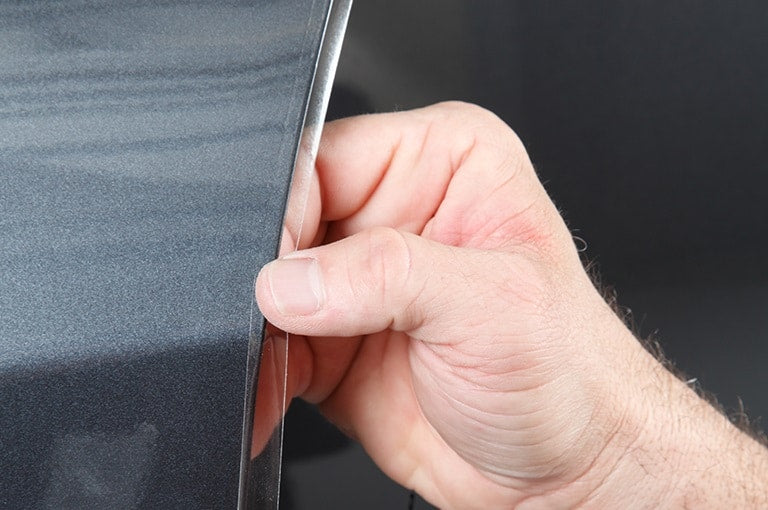
Once all of the surfaces have been prepped, the installer will cut the PPF sheet down to size in preparation for installation, much like window tint. This is typically done in sections, with areas like the hood, rocker panels, quarter panels, side mirrors, door, and various other portions being measured and mocked-up for installation.
3. Spray and Pray

Installing PPF requires an activator, or a fitting solution. 3M recommends using a two-solution application method here for optimal results. For a soap solution, just fill a 16 oz. spray bottle with water and add .6ml (4 drops) of Johnson’s Baby Shampoo or Aveeno Baby Wash /Shampoo.
An alternative option, is the full isopropyl alcohol blend wipe-down approach. Simply fill a 16 oz. spray bottle 75% full of water and then top it off with 25% isopropyl alcohol with a 70% rubbing alcohol rating. Remember to wash your hands before starting this stage of the application, as it helps avoid the imprinting of oily fingerprints on the adhesive.
4. All Lubed-Up and Ready for Action
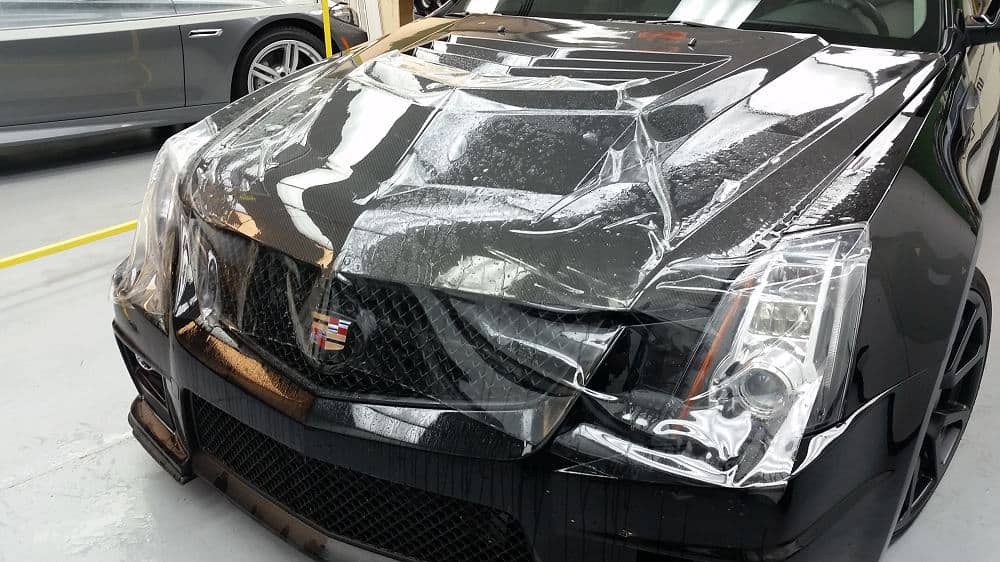
Once the top surface of the film is wet with the solution of your choosing it’s time for the squeegee lovefest to begin. But while your squeegee may slide effortlessly across the filmy surface, it’s worth noting this is when it pays to be a pro.
Paint protection films don’t always like to fit perfectly when applied, and as we previously mentioned, is typically far more finicky than vinyl. This stage in the PPF install process involves a series of spraying, moving, squeegeeing, repositioning, and re-squeegeeing to remove any bubbles or creases in the film.
5. Fire in the Hole!
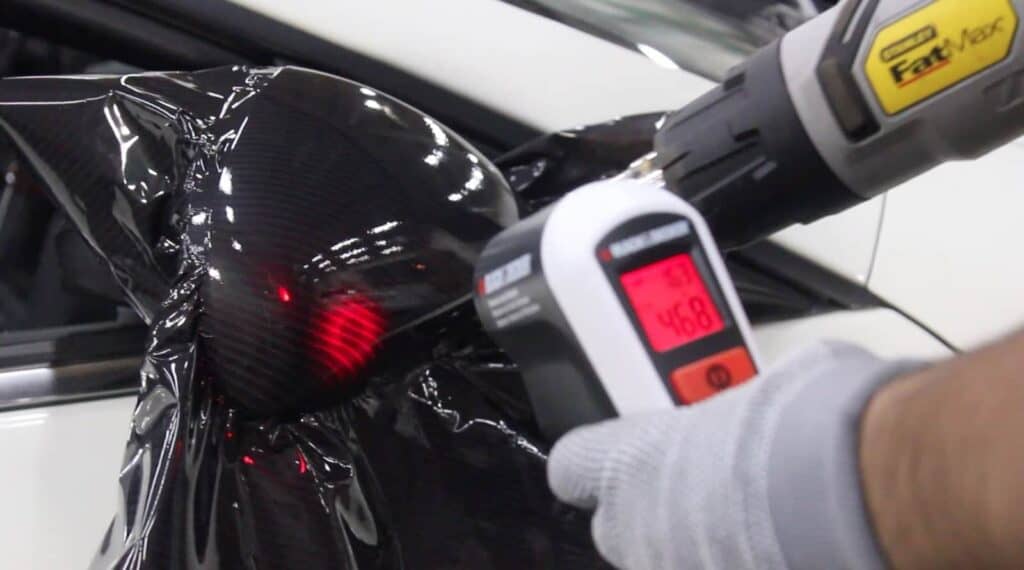
Once the PPF has been properly applied, and any lingering bubbles and/or creases have been removed, it’s time to bring the heat. Here, the use of an industrial heat gun and a touchless instant temp reader are used to activate the adhesive, and thus cause the PPF to stick to the surface. This stage also causes the material to shrink, creating a clean, tight fit on whatever it is protecting.
How Long Does PPF Take to Install?
The time taken for paint protection film installation depends on the amount of surface you are covering. This can vary from 2-5 days on average.
How Long Does PPF Take to Cure?
PPF’s in-shop curing period usually lasts for not more than 12 hours. However, the time can vary based on the type of PPF and who installs it.
How to Clean PPF
PPF is different from your car’s usual painted surface. Hence, you need to know how to wash your car's filmed surface.
How to Wash a Car With PPF
First, you need to choose the correct products for washing PPF. These are:
- A pH-neutral soap or shampoo
- Soft cleaning tools like microfiber or sponge
Then, fill two buckets with water; mix soap in one and leave the other clean. Remember, dirty = not good (at least in this case). So, after every pass with your sponge, dip it in the clear water to rinse it before putting it back into the soapy water.
If you follow this method, you will not just prevent the PPF from contamination but keep the surface swirl-free.
You can then dry your car with a microfibre or leave it to air dry. If you want to save time, you can also use a leaf blower. But no matter what you do, ensure the surface has no water spots.
How to Wash a Car With PPF and Ceramic Coating
The two-bucket method mentioned above also applies to cars with a ceramic coating on top of their paint protection film.
However, you will have to keep the following things in mind:
- Don't wash the car under sunlight or when its paint is hot.
- Using a delicate washing product.
- Only wash your car with a premium wash media.
Lastly, do not go to an automated car wash as that can inflict scratch or swirl marks.
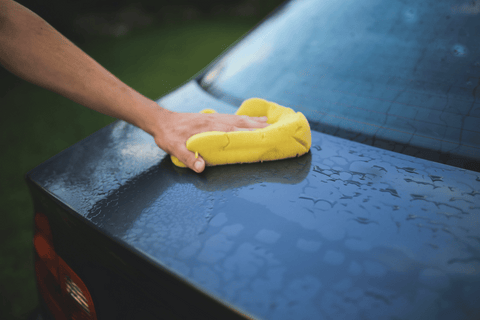
How to Remove PPF
If, for some reason, you wish to remove the PPF from your car, follow the given procedure.
Step 1: Prepare
Choose the panel you want to start with and heat the surface using a blow torch. If you do not have a blow torch, put a microfiber cloth on the panel and pour hot water on it.
Ensure the entire panel is heated up edge-to-edge. The panel should be ready for removal after 5 to 10 minutes.
Step 2: Peel
Pick one of the corners and gently peel it while maintaining the film’s grasp closer to the surface. If you feel that the film has hardened, heat it again and then keep peeling.
Ensure the adhesive has loosened before peeling, or you might also peel off some paint.
The peeling process might take some time, but you should not expedite the process by using sharp objects. Using such tools might damage your car’s surface.
Step 3: Polish
While most glue should come off with the film, you might find some residue on your car’s paint. You can again use the heat gun to melt the adhesive. Even a hair dryer would work.
You can also use an adhesive removal product and a microfibre towel to rub off the remaining residue. Always use soft and delicate tools, as even plastic can leave marks on your paint.
Polish your car clean with soap and a sponge to wipe off any remaining contaminants and chemicals. Avoid automatic car washes and rely on manual techniques.
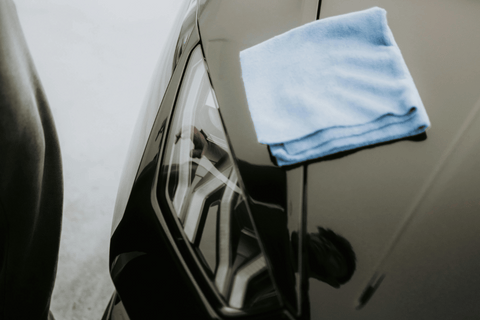
How Long Does Paint Protection Film Last?
Arguably the best attribute of a paint protection film is its longevity. According to 3M, a professionally installed paint protection film should last anywhere from 5 to 10 years. This explains why many of these products are covered by a warranty when the installation is conducted by a certified company specializing in PPF installations.
That said, much like car wax, ceramic coatings, or any other form of paint protection for that matter, there are a few variables that may impact product longevity. Some of the more common factors that impact a PPF’s longevity are:
- Shitty Surface Prep
- Piss-Poor Application Etiquette
- Environmental Ass-Kickings
Pros and Cons of Paint Protection Film
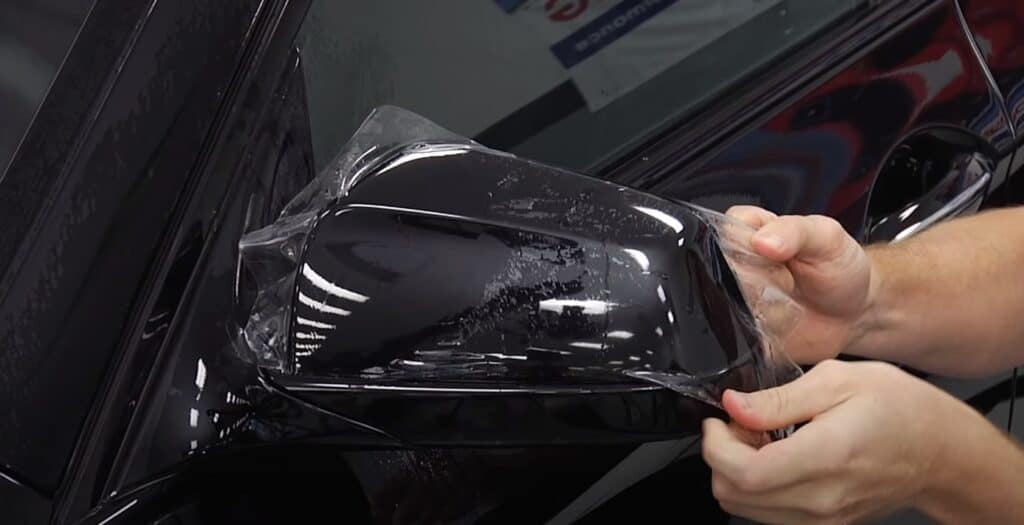
PPF Pros
- Superior protection against rock chips and scratches
- Prevents the formation of paint swirls
- Near Deadpool-like self-healing properties
- Can last up to 10 years when properly maintained
PPF Cons
- Can reduce the shine of a vehicle’s paint if not pampered
- Not always very hydrophobic. (Many professional PPF installers suggest a ceramic coating application services on top of a fresh layer of PPF for unrivaled paint protection.)
- Inferior PPF products and knock-offs will often discolor and develop a yellowish tinge
- Once damaged, it will need to be completely removed and replaced
- Not a very good DIY solution
- Has been known to damage paint if left for too long and not properly maintained
- Most expensive modern paint protection product
How to Get the Most Out of a Paint Protection Film
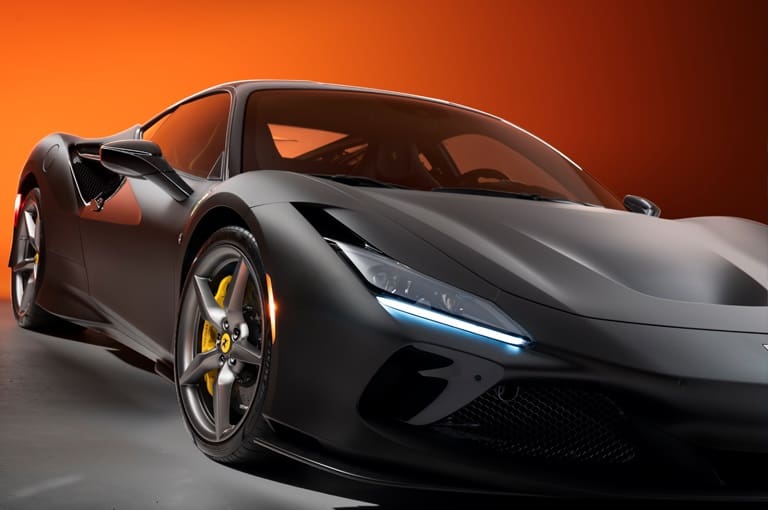
Almost all of the cons listed above can be negated by combining a high grade PPF with a quality ceramic coating. This is why a lot of performance car owners will only install a PPF on the front portions of a vehicle (where rock chips and acidic bug guts are most prone to fucking shit up), and then apply a 9H-rated ceramic coating on top of this PPF, as well as other areas of the vehicle.
This helps to improve shine (PPF is notorious for becoming dull over time) and improve the surface’s water and debris-repelling hydrophobic properties. This will also cut down on the need for frequent car washes and wax installs, thus saving the vehicle owner significant amounts of time and labor.
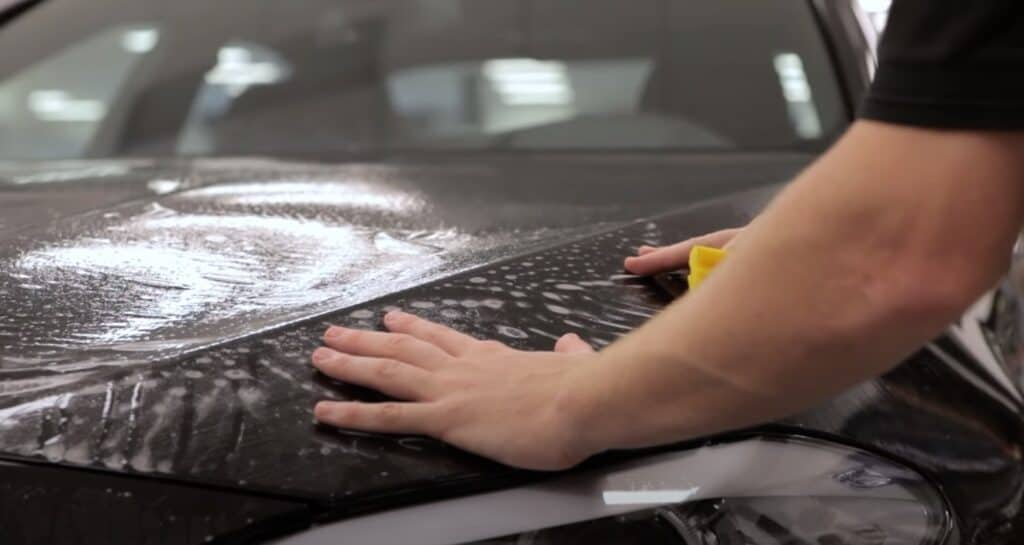
PPF vs. Ceramic Coating
Whether PPF or ceramic coating, both offer substantial potential for the exterior of your car. They are similar in multiple ways. However, we should also examine the differences between ceramic coating and paint protection film.
For instance, PPF offers superior protection against debris and small rocks but dulls the glossiness of the surface. On the other hand, ceramic coating offers a more permanent solution to the issue and rather enhances a car’s shine.
Can You Ceramic Coat PPF?
Yes, you can ceramic coat paint protection film if you wish to do so. Combining the two materials gives you a surface that protects your car’s paint and lasts significantly longer.
However, not every PPF lets you put a ceramic coating on top of it. Hence, if you do not have a film that allows so, you might have to peel that off and start from scratch (pun intended).
Best Ceramic Coating for PPF
To enjoy the best of both worlds, you want a ceramic coat that is easy to apply yet offers robust results.
The Armour Shield IX DIY ceramic coating kit is just what you need. It spreads smoothly over paint protection film and delivers a shine like never before.
This is all you need if you are looking for a hassle-free ceramic coating.
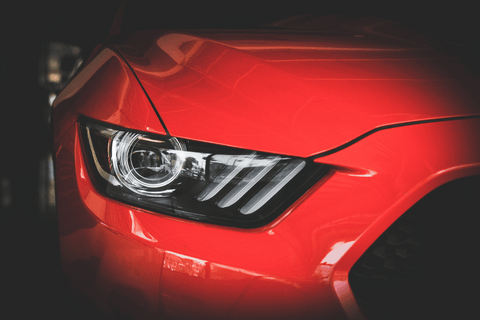
Can You Wax PPF?
Although it is possible to apply wax on PPF, it is not recommended. This is because the wax might negatively affect the film’s performance.
Can I Apply Paint Protection Film On Headlights?
Yes, applying PPF on headlights is a smart investment. It will protect the headlights from debris, rocks, and dust, ensuring they retain their original clarity and intensity for a long time.
Can You Polish PPF?
If needed, you can polish paint protection film. However, ensure you are not heating the surface of your car while doing so. Else, the layer will start to peel off.
Does PPF Protect Against Rock Chips?
Yes, PPF protects your vehicle against rock chips as long as they are not too big. However, this is only true if the PPF is properly installed.
Can You Put PPF Over Ceramic Coating?
No, PPF cannot stick on the surface of a ceramic-coated vehicle. One of the key properties of a good quality ceramic coat is that it makes the surface slick. On the contrary, you can apply a ceramic coating on top of PPF.
Does PPF Damage Paint?
No, if the PPF is applied by a professional with proper care, it will not damage your car’s paint.
Does PPF Protect Against Keying?
Yes, paint protection film does protect your car’s paint against keying to some extent.
Can You Wrap Over PPF?
Yes, if you want to change the appearance of your already PPF-installed car, you can wrap over it. The results will be the same whether the film is smooth or matte-finished.
Can You Take PPF Through Car Wash?
No, you should not take your PPF through a car wash as those automatic machines might leave swirl marks on it. Instead, take your car to get manually washed or wash it yourself at home.
Parting Shots, and a Verdict on Paint Protection Film
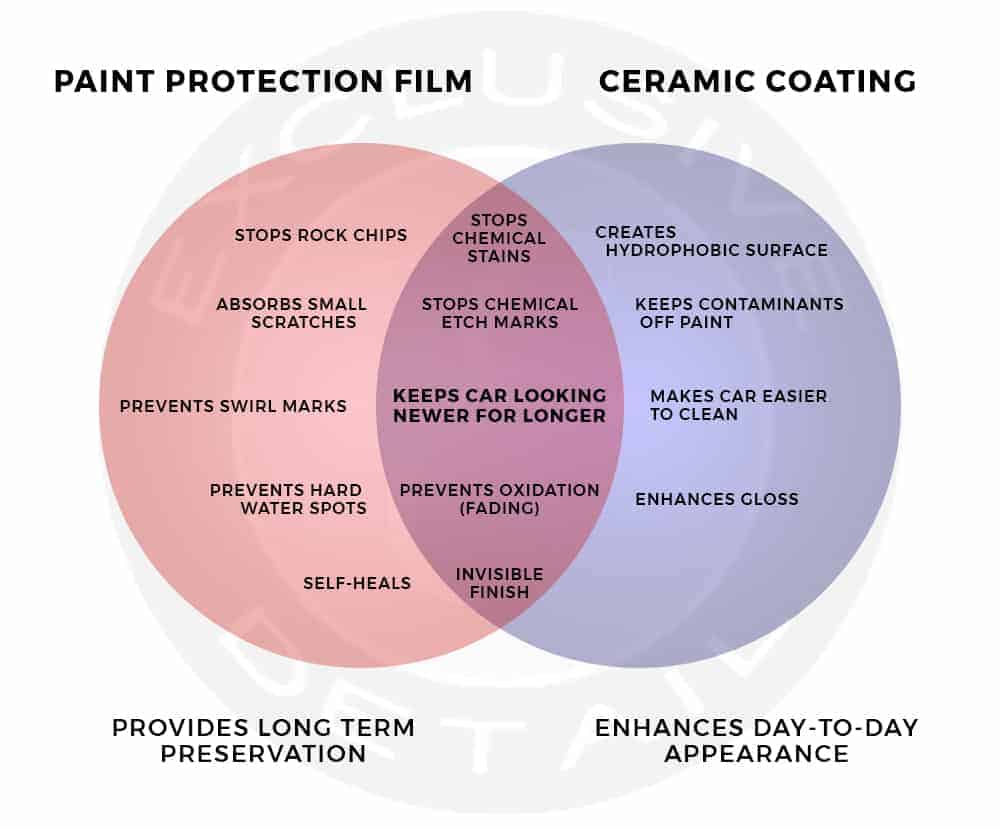
Paint protection films, or PPF, are an outstanding way to shield a vehicle’s surfaces from damage caused by the worlds most abrasive debris. However, it isn’t really intended to enhance the luster of a paint job either, nor is it very good at keeping vehicle surfaces clean.
So is a high-end PPF worth the up-front cost and the steep fees associated with utilizing a pro installer? That’s for you to decide. Living in a harsh environment and beating the ever-loving shit out of your beloved daily beater every day? Then it’s probably time to upgrade to a PPF, and then coat it with a slathering of Armor Shield IX ceramic coating.














92 comments
ppf victim
Had this film installed on dark blue paint for about 4 years, I think it was 3M. So, the car was parked with one side next to a house wall all this time. In time, that side next to the wall developed no cracking and less glue eating into a clear coat along the cut film edge, but the other side, more exposed to elements cracked more and the glue started failing from the edge of the film over paint by changing clear coat color to some dark shade. Also, along the film cut edge over paint, the glue started making tiny micro holes into clear coat. You can see film edge made impression into clear coat resulting in a straight line.
The verdict, install this film on black or some very dark car paint to avoid visible damage if you don’t remove it before it’s too late OR keep removing and applying new film at least every couple years and care about that film even more than you would normally do for the paint OR keep your car in garage most of the day, but then why would you even need this film headache if your car is not driven often. Also, avoid applying just strips of film which cut edge would be crossing you paint surface – this where glue fails, on film cut edge, and it starts eating into the clear coat surface, do the whole hood instead, bumper, roof, etc., but, if rock hits film and punctures a hole, this is where glue starts reacting with air elements, UV, and starts changing color, also reacting with paint. And your film will get some damage over time, but if you insert a patch, this is where you introduce film edge and its glue to air, which starts doing it evil job on your paint.
I removed this hard, cracked film with light solvent that would get under the film and I simply peeled it off by shoving a piece of transparent hard thin plastic under it. It took me couple evenings, at least, to complete 2/3 of the hood with the worst damaged film. Not a scratch on car paint aside from the film glue damage. Cracked film chunks were very hard, not flexible, and just crumbled like egg shell, but the other side of the hood peeled somewhat easily off the hot-under-the-sun hood as the film was still somewhat flexible. I will never, ever use it again, at least on this car, unless I have my future car under conditions I listed above. Sun’s UV is a very, very harsh form of ionizing radiation, nothing lasts when exposed to it.
Had this film installed on dark blue paint for about 4 years, I think it was 3M. So, the car was parked with one side next to a house wall all this time. In time, that side next to the wall developed no cracking and less glue eating into a clear coat along the cut film edge, but the other side, more exposed to elements cracked more and the glue started failing from the edge of the film over paint by changing clear coat color to some dark shade. Also, along the film cut edge over paint, the glue started making tiny micro holes into clear coat. You can see film edge made impression into clear coat resulting in a straight line.
The verdict, install this film on black or some very dark car paint to avoid visible damage if you don’t remove it before it’s too late OR keep removing and applying new film at least every couple years and care about that film even more than you would normally do for the paint OR keep your car in garage most of the day, but then why would you even need this film headache if your car is not driven often. Also, avoid applying just strips of film which cut edge would be crossing you paint surface – this where glue fails, on film cut edge, and it starts eating into the clear coat surface, do the whole hood instead, bumper, roof, etc., but, if rock hits film and punctures a hole, this is where glue starts reacting with air elements, UV, and starts changing color, also reacting with paint. And your film will get some damage over time, but if you insert a patch, this is where you introduce film edge and its glue to air, which starts doing it evil job on your paint.
I removed this hard, cracked film with light solvent that would get under the film and I simply peeled it off by shoving a piece of transparent hard thin plastic under it. It took me couple evenings, at least, to complete 2/3 of the hood with the worst damaged film. Not a scratch on car paint aside from the film glue damage. Cracked film chunks were very hard, not flexible, and just crumbled like egg shell, but the other side of the hood peeled somewhat easily off the hot-under-the-sun hood as the film was still somewhat flexible. I will never, ever use it again, at least on this car, unless I have my future car under conditions I listed above. Sun’s UV is a very, very harsh form of ionizing radiation, nothing lasts when exposed to it.
Teresa Iacoboni
Do you have any coatings that make it easier to remove spray paint tagging from my truck. I am tired of having to repaint it. Thanks
Do you have any coatings that make it easier to remove spray paint tagging from my truck. I am tired of having to repaint it. Thanks
smartautouae
Thanks for sharing such an informative article.If you’re looking for tinting for your car, smart-auto is a perfect choice.Whether it is for your car’s paint protection(PPF),car Detailing, nano ceramic coating, car wrapping, and any other services please visit our nearest branch at MotorCity, Al Quoz, Mirdif. Keep your car cool, and your passengers comfortable.
Thanks for sharing such an informative article.If you’re looking for tinting for your car, smart-auto is a perfect choice.Whether it is for your car’s paint protection(PPF),car Detailing, nano ceramic coating, car wrapping, and any other services please visit our nearest branch at MotorCity, Al Quoz, Mirdif. Keep your car cool, and your passengers comfortable.